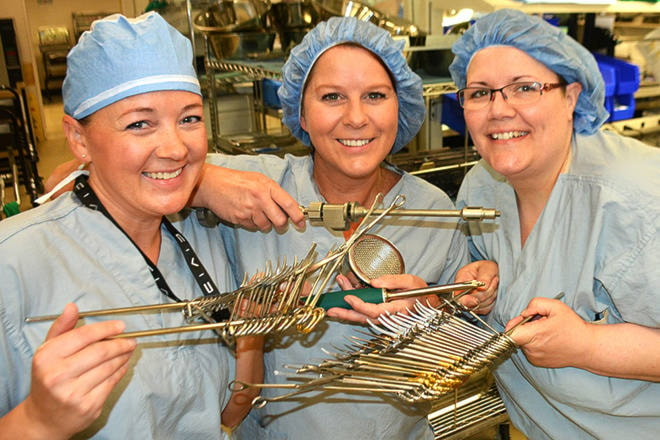You might call them the unsung heroes of Penticton Regional Hospital’s operating rooms.
A staff of 27 Medical Device Reprocessing (MDR) technicians work behind the scenes, making sure medical instruments are sterile and ready, and preparing operating rooms with equipment for the many operations that happen on a daily basis.
They disassemble, clean, reassemble, function-test and sterilize the different surgical instruments and support the hospital in many ways, working in a little bit of obscurity, currently located in the PRH basement.
Related: Hospital implements electronic charting
“I wish people knew more in-depth what we do,” said Tanya Galpin, an MDR Technician who has worked at PRH for 16 years. “I don’t think people realize what goes into reprocessing every single instrument that is used in the hospital, not just the (surgical) instruments, but there is equipment like feeding pumps and respiratory devices that we are cleaning and reprocessing as well.”
Medical Device Reprocessing is a department most members of the public might not know much about. But in the bowels of the Penticton Regional Hospital, the hard-working team is often times looking ahead and back at the same time, cleaning up after a day and planning for the next day’s scheduled operations.
While dealing with surgical instruments makes up a large part of their day, MDR technicians also bring patients to the operating rooms prior to surgery amongst their other duties.
Related: Hospital tower to be named after philanthropist
“We have a variety of duties,” said Tina Battie, who joined PRH’s MDR department in 2007 after emigrating from England. “We bring the checked-in patients to the operating room waiting area. It’s a really nice variety of having some patient contact along with our other roles.”
Reprocessing of medical instruments is a complex task as MDR technicians follow manufacturers’ guidelines and utilize a computer system to properly sterilize instruments and equipment that is used throughout the hospital, ensuring patient safety at all times. Technicians not only work with the operating rooms at PRH, they are also responsible for instrument reprocessing at smaller hospitals in the region such as Oliver and Keremeos and work with community health services such as mid wives.
It’s a job that keeps changing with every day, bringing new challenges.
“The involvement with the OR is definitely an interesting part of the job. We see a variety of operations,” said Lisa Schyrbiak, an employee at PRH since 2007. “I’ve also been on shift during an organ retrieval where teams fly in from across the country, with their coolers, waiting in the OR corridor for viable organs to deliver to awaiting transplant recipients. The job is just forever changing. There are always new and interesting cases coming in.”
Currently the MDR Department is located in the basement of PRH, however the department will be much improved when the new Patient Care Tower officially opens, set for late April 2019. The department is moving up to the third floor and will expand in a big way, giving the team much more room to work.
“There are going to be a lot of things that are going to make our job a little easier for us and better for our bodies,” said Galpin. “I’m looking forward to getting into a new and bigger space. Moving from the basement to the third floor, we are going to have windows and we are all very excited about that as well.”
New equipment will also improve things like communication.
“When we talk to the OR now we are just using our phones but when the tower opens we will have (technology in place) where we can contact people directly,” said Battie. “We’re going to have a lot of space to grow into.”
Extra space and new equipment will allow for better organization and a streamlined service, added Schyrbiak.
“We’re pretty small right now,” she said. “We’re bursting at the seams. Right now we find little rooms to store our equipment but it will be so nice to have it organized and a big space. It will be way more efficient. We will have room for everything. It’s a much needed change.”
At six storeys high and 280,000 square feet, the David E. Kampe patient care tower will increase capacity and functionality of ambulatory care services, include five new operating rooms, 84 new single patient rooms, a rooftop helipad and space to allow the UBC Faculty of Medicine program to expand. The new Patient Care Tower project will also accommodate renovations to significantly expand the emergency department and update the pharmacy, supplies and equipment stores in the existing hospital.
